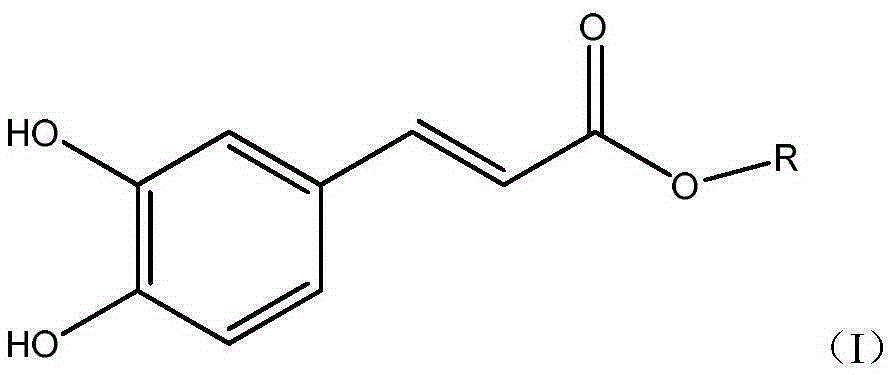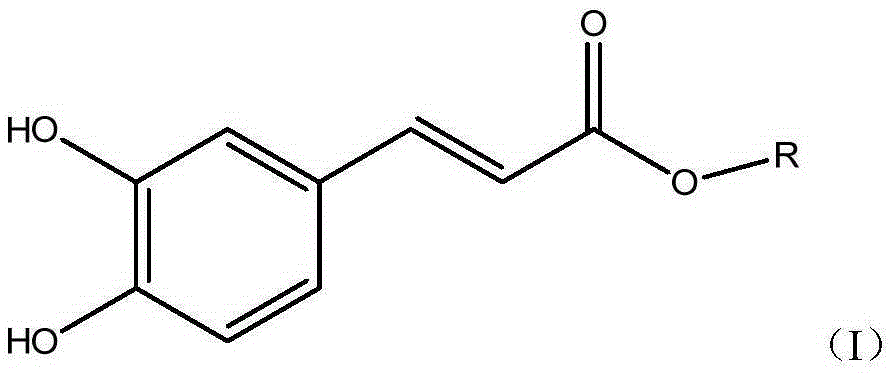Application of caffeic acid and its alkyl esters in the control of bacterial wilt
A technology for bacterial wilt disease and caffeic acid, which is applied in the field of biological bacteriostatic agents, and the application of caffeic acid alkyl esters in the prevention and control of bacterial wilt disease, can solve problems such as unreported, and achieve the effect of inhibiting bacterial wilt bacteria.
- Summary
- Abstract
- Description
- Claims
- Application Information
AI Technical Summary
Problems solved by technology
Method used
Image
Examples
Embodiment 1
[0033] In this example, the plate confrontation method was used to detect the inhibitory effect of caffeic acid alkyl esters on R. solanacearum.
[0034] Solanacearum No. 5 race, that is, Morus solanacearum RS-5 in LB liquid medium (peptone 10g; yeast powder 10g; sodium chloride 5g; distilled water 1000mL; pH (6.97-7.10) 150r / min, 30 ℃ conditions Cultivate overnight with shaking to obtain a bacterial suspension.
[0035] Caffeic acid, methyl caffeate, ethyl caffeate, propyl caffeate, isopropyl caffeate, butyl caffeate, amyl caffeate, isopentyl caffeate, hexyl caffeate, heptyl caffeate , octyl caffeate, nonyl caffeate, decyl caffeate and phenethyl caffeate were dissolved in a co-solvent, prepared into a 1g / L solution, and sterilized by filtration with a 0.22 μm microporous membrane.
[0036] Plate confrontation method: prepare LB solid medium (peptone 10g; yeast powder 5g; sodium chloride 10g; agar 17g; distilled water 1000mL; pH6.97-7.10), and spread the bacterial suspension ...
Embodiment 2
[0040] In this example, the plate confrontation method was used to detect the caffeic acid alkyl ester with the best inhibitory effect on R. solanacearum.
[0041] The No. 5 race of R. solanacearum, ie, R. solanacearum RS-5, was shaken and cultivated overnight in LB liquid medium at 150 r / min and 30° C. to obtain a bacterial suspension.
[0042] Caffeic acid, methyl caffeate, ethyl caffeate, propyl caffeate, isopropyl caffeate, butyl caffeate, amyl caffeate, isopentyl caffeate, hexyl caffeate, heptyl caffeate , octyl caffeate, nonyl caffeate, decyl caffeate and phenethyl caffeate were dissolved in a co-solvent, prepared into a 1g / L solution, and sterilized by filtration with a 0.22 μm microporous membrane.
[0043] Plate confrontation method: prepare LB solid medium, spread the 10-fold diluted bacterial suspension evenly on the plate with the plate coating method, punch 3 holes with a puncher, and put 70 μL caffeic acid alkyl in each hole Esters, use a cosolvent as a blank cont...
Embodiment 3
[0047] The present embodiment adopts spectrophotometry to detect the inhibitory effect of caffeic acid alkyl esters in the lowest concentration range on Ralstonia solanacearum, and the specific methods are as follows:
[0048] The No. 5 race of R. solanacearum, ie, R. solanacearum RS-5, was shaken and cultivated overnight in LB liquid medium at 150 r / min and 30° C. to obtain a bacterial suspension.
[0049] Alkyl caffeate was dissolved in a co-solvent to prepare a 60 g / L solution, which was sterilized by filtration with a 0.22 μm microporous membrane.
[0050] Prepare LB liquid medium, put 2mL liquid medium in each test tube, filter and sterilize the caffeic acid alkyl ester with a 0.22 μm microporous membrane, and set different concentrations of the caffeic acid alkyl ester.
[0051] Each test tube was inoculated, and each bacterial strain and each caffeic acid alkyl ester were repeated three times.
[0052] The inoculated culture medium was shaken at 30°C for 24 hours.
[...
PUM
 Login to View More
Login to View More Abstract
Description
Claims
Application Information
 Login to View More
Login to View More - R&D
- Intellectual Property
- Life Sciences
- Materials
- Tech Scout
- Unparalleled Data Quality
- Higher Quality Content
- 60% Fewer Hallucinations
Browse by: Latest US Patents, China's latest patents, Technical Efficacy Thesaurus, Application Domain, Technology Topic, Popular Technical Reports.
© 2025 PatSnap. All rights reserved.Legal|Privacy policy|Modern Slavery Act Transparency Statement|Sitemap|About US| Contact US: help@patsnap.com



